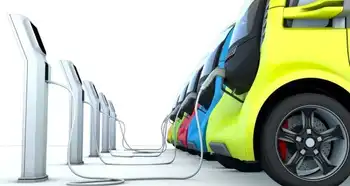Cranking the Volt to 100 mpg
On the window sticker of the electric Tesla roadster, which depicts a battery instead of a gas pump, energy use is expressed in kilowatt hours per 100 miles.
Nearly two years later that car, the Chevrolet Volt — designed to make most trips on battery power alone, but equipped with a gasoline engine to provide electricity when the lithium-ion cells are depleted — has advanced from a design study to a model headed for production. The time is fast approaching when Mr. Lutz’s teaser must be squared with the reality of government-approved ratings.
Around Detroit, the certainty of a Volt mileage rating above 100 mpg is todayÂ’s worst-kept secret. The only unknown is how much more than 100 the window sticker will read, because the sticky process of deciding exactly how to rate a new generation of hybrid-powered cars is still being worked out.
Often criticized as the killer of kilowatt cars, GM is now the champion of their revival. The Volt, which the company plans to begin selling in November 2010, should easily double the fuel economy rating of todayÂ’s mileage hero, the Toyota Prius. The Prius, which carries a 46 mpg rating in combined city and highway driving, is a conventional hybrid that uses modest amounts of electricity to minimize the fuel consumed by its gasoline engine.
The Volt takes the opposite approach, relying mainly on electric power, with its gasoline engine running only when needed to stretch the driving range. The 100 mpg automobile, which once seemed an impossible dream, will become an official E.P.A.-rated reality with the VoltÂ’s arrival.
GM calls the car an extended-range electric vehicle, or E-REV. For the first 40 miles after leaving home with a fully charged battery, the Volt will consume no gas at all, according to GM; when the gas engine does fire up, it will only drive a generator — the engine is not connected to the wheels. Owners will recharge the battery overnight from a wall socket, which brings the Volt into the category of plug-in hybrids.
Placing a meaningful mileage rating on a car capable of running through the governmentÂ’s test cycles without using any gas at all is no simple matter. Still, the Volt will consume gas on trips longer than its 40-mile battery-powered range, so it must carry some guide to consumption on its window sticker.
Mileage ratings are one of the E.P.A.Â’s reasons for being. In 1975, the Energy Policy and Conservation Act heaped a thankless task on this agencyÂ’s plate: directing carmakers to attach labels to the vehicles they sell showing fuel economy, estimated annual fuel costs and the range of fuel economy achieved by comparable vehicles.
It is also the E.P.A.Â’s responsibility to help automakers determine the figures that go on those labels, a job only slightly less daunting than weather forecasting. The specific test procedures used to generate mileage figures can be revised only by an act of Congress, but the E.P.A. has made regular adjustments in the mileage reported to consumers in response to changes in driving habits, traffic conditions and vehicle design. Trimming the 2008 model-year mileage figures by about 20 percent from previous yearsÂ’ results yielded the best correlation yet between what automakers post on window stickers and what consumers experience on the road, especially for hybrid vehicles.
The latest hybrids and electrics are not the first deviations from ordinary gasoline-fueled automobiles the E.P.A. has faced. Vehicles that run on pure electricity, mixtures of gasoline and E85 ethanol, compressed natural gas and hydrogen (fuel-cell vehicles now in the demonstration stage) all required adjustments — in layman’s terms, fudge factors — to the way energy consumption is reported. It is no longer a strictly scientific measurement, but takes into account compensating factors.
The Tesla Roadster, an all-electric sports car that is now being delivered to early customers, is an interesting example of this process. Because the Tesla never consumes petroleum while driving, the E.P.A.-required window sticker lists the energy consumed in kilowatt-hours of electricity. Translating the Roadster’s numbers — 32 kilowatt hours per 100 miles in town and 33 on the highway — to more familiar units using a textbook conversion factor yields impressive ratings of 105 mpg in the city and 102 on the highway. But applying the adjustment factor devised by the Energy Department, which takes into account not only energy content but also such considerations as scarcity of the fuel and production and distribution efficiency, yields far more impressive mileage figures: 256 mpg in the city and 249 on the highway.
In the electric-car realm, the prevailing attitude seems to be the more the merrier, in part because of provisions in the governmentÂ’s Corporate Average Fuel Economy rules, which let automakers earn credits for exceeding the minimum requirements. While mileage credits cannot yet be swapped company to company, Tesla Motors hopes that will change, eventually permitting it to sell mileage credits to brands burdened with gas-guzzling models.
But the vehicle technologies already addressed by the E.P.A. do not provide a procedure suitable for measuring the mileage of a plug-in vehicle like the Chevy Volt. According to Jon Lauckner, vice president for global program management at G.M., the Volt can complete six of the 11-mile-long city cycles or the same number of 10.3-mile highway cycles on one battery charge.
The E.P.A. turned to the Argonne National Laboratory, one of 21 Energy Department research centers and a regular ally in mileage matters, to formulate a way to assess the new hyper-efficient vehicles using existing test procedures.
Michael Duoba, an engineer with the Center for Transportation Research at Argonne, about 25 miles from Chicago, explained the thinking behind the new methods his group is developing. “Our priority is instituting m.p.g. figures that are rational and reasonable,” he said. “The new results must be comparable to the mileage achieved by conventional vehicles of the past and present. Also, all of the new advanced technologies must be fairly represented.”
What makes this difficult is the way plug-in vehicles operate. Unlike gasoline, diesel, hybrid, flex-fuel and even fuel-cell vehicles, plug-in vehicles have two distinct operating routines.
“During the first 40 or so miles of driving, the Chevy Volt runs on energy from its battery in what we call a charge-depleting mode,” Mr. Duoba said. “Then, after the battery reaches the minimum acceptable state of charge, the Volt’s gasoline engine starts and this car continues in what we call its charge-sustaining mode.”
Mr. DuobaÂ’s game plan is to repeatedly use the E.P.A.Â’s driving cycles to measure the VoltÂ’s consumption in both of its operating modes. (In addition to the familiar city and highway tests, cycles for high speed, air-conditioning and cold temperature conditions were added to help bring the final label closer to real-world driving experience.)
First, the Volt is driven repeatedly on each E.P.A. test cycle until its battery is depleted to determine the number of kilowatt-hours of electricity consumed and the number of miles accumulated. Using an Energy Department Petroleum Equivalency Factor established for electrics and hybrids in 2000, the electric consumption is then converted to gallons of gasoline.
Next, the Volt is driven repeatedly on the same test cycle in its charge-sustaining mode, with the gasoline-powered generator, rather than the batteries, providing electricity. That yields a second set of gallons-consumed and miles-accumulated figures.
Now for the tough part: blending the total gallons consumed and miles driven together in some credible way to obtain final city and highway mileage figures suitable for posting on the VoltÂ’s window sticker. ArgonneÂ’s intention is to use what it calls a utility factor, in essence a driving trip that consists of some charge-depleting miles and some charge-sustaining miles.
Plug-in hybrids with a long charge-depleting range like the Volt should not have any difficulty clearing the 100-mpg hurdle, Mr. Duoba said. Preliminary tests of the plug-in Prius that Toyota plans to introduce in 2010 indicates that it will achieve 70 to 90 mpg Of course, the final results will depend on the utility factor. Mr. Duoba said that the Transportation DepartmentÂ’s National Highway Transportation Survey, current research studying consumer driving habits and input from carmakers would all factor into ArgonneÂ’s utility factor. Once there is consensus, the Society of Automotive Engineers will publish the Argonne-designed test procedure as its Standard J1711: Recommended Practice for Measuring Exhaust Emissions and Fuel Economy of Hybrid Electric Vehicles.
That leaves one last issue open for discussion. To separate the Volt from ordinary hybrids like the Prius, and to earn zero-emissions-vehicle credits in California, G.M. hopes to define its mileage hero as something truly different.
Because the Volt is always powered by electricity, GM says it should not be lumped into the same category as hybrids that use both gasoline and electric propulsion, preferring to call the Volt — and other products that will share its technology — extended-range electric vehicles.
Adding another category to the vehicular mix poses a knotty question: if the Volt is not a hybrid, as GM contends, how can the S.A.E.Â’s hybrid electric vehicle test procedure be used to tell the world that the Chevy is a genuine 100 mpg automobile?
Related News

WY Utility's First Wind Farm Faces Replacement
WYOMING - A Wyoming utility company has filed a permit to replace its first wind farm—originally commissioned in 1998, composed of over 65 turbines—located at Foote Creek Rim I. The replacement would downsize the number of turbines to 12, which would still generate roughly the same energy output.
According to the Star Tribune, PacifiCorp’s new installation would involve new nacelles, new towers and new blades. The permit was filed with Carbon County.
New WY Wind Farm
The replacement wind turbines will stand more than twice as tall as the old: Those currently installed stand 200 feet tall, whereas their replacements will tower closer…





